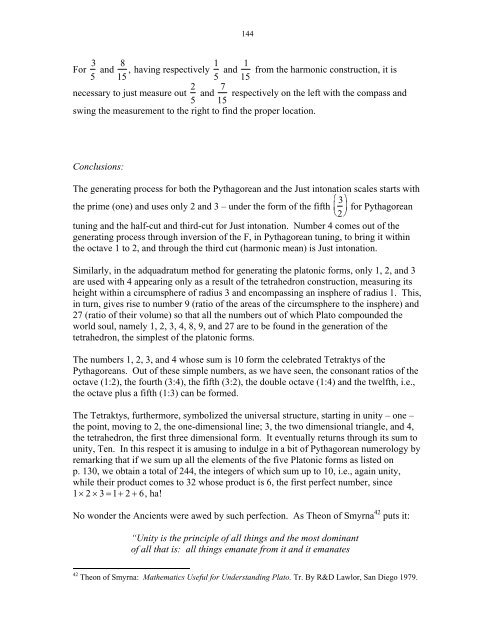Ad Quadratum Construction and Study of the Regular Polyhedra
Ad Quadratum Construction and Study of the Regular Polyhedra
Ad Quadratum Construction and Study of the Regular Polyhedra
You also want an ePaper? Increase the reach of your titles
YUMPU automatically turns print PDFs into web optimized ePapers that Google loves.
For 3<br />
5<br />
144<br />
8<br />
1 1<br />
<strong>and</strong> , having respectively <strong>and</strong> from <strong>the</strong> harmonic construction, it is<br />
15 5 15<br />
7<br />
<strong>and</strong> respectively on <strong>the</strong> left with <strong>the</strong> compass <strong>and</strong><br />
5 15<br />
necessary to just measure out 2<br />
swing <strong>the</strong> measurement to <strong>the</strong> right to find <strong>the</strong> proper location.<br />
Conclusions:<br />
The generating process for both <strong>the</strong> Pythagorean <strong>and</strong> <strong>the</strong> Just intonation scales starts with<br />
<strong>the</strong> prime (one) <strong>and</strong> uses only 2 <strong>and</strong> 3 – under <strong>the</strong> form <strong>of</strong> <strong>the</strong> fifth 3 <br />
<br />
2<br />
<br />
for Pythagorean<br />
<br />
tuning <strong>and</strong> <strong>the</strong> half-cut <strong>and</strong> third-cut for Just intonation. Number 4 comes out <strong>of</strong> <strong>the</strong><br />
generating process through inversion <strong>of</strong> <strong>the</strong> F, in Pythagorean tuning, to bring it within<br />
<strong>the</strong> octave 1 to 2, <strong>and</strong> through <strong>the</strong> third cut (harmonic mean) is Just intonation.<br />
Similarly, in <strong>the</strong> adquadratum method for generating <strong>the</strong> platonic forms, only 1, 2, <strong>and</strong> 3<br />
are used with 4 appearing only as a result <strong>of</strong> <strong>the</strong> tetrahedron construction, measuring its<br />
height within a circumsphere <strong>of</strong> radius 3 <strong>and</strong> encompassing an insphere <strong>of</strong> radius 1. This,<br />
in turn, gives rise to number 9 (ratio <strong>of</strong> <strong>the</strong> areas <strong>of</strong> <strong>the</strong> circumsphere to <strong>the</strong> insphere) <strong>and</strong><br />
27 (ratio <strong>of</strong> <strong>the</strong>ir volume) so that all <strong>the</strong> numbers out <strong>of</strong> which Plato compounded <strong>the</strong><br />
world soul, namely 1, 2, 3, 4, 8, 9, <strong>and</strong> 27 are to be found in <strong>the</strong> generation <strong>of</strong> <strong>the</strong><br />
tetrahedron, <strong>the</strong> simplest <strong>of</strong> <strong>the</strong> platonic forms.<br />
The numbers 1, 2, 3, <strong>and</strong> 4 whose sum is 10 form <strong>the</strong> celebrated Tetraktys <strong>of</strong> <strong>the</strong><br />
Pythagoreans. Out <strong>of</strong> <strong>the</strong>se simple numbers, as we have seen, <strong>the</strong> consonant ratios <strong>of</strong> <strong>the</strong><br />
octave (1:2), <strong>the</strong> fourth (3:4), <strong>the</strong> fifth (3:2), <strong>the</strong> double octave (1:4) <strong>and</strong> <strong>the</strong> twelfth, i.e.,<br />
<strong>the</strong> octave plus a fifth (1:3) can be formed.<br />
The Tetraktys, fur<strong>the</strong>rmore, symbolized <strong>the</strong> universal structure, starting in unity – one –<br />
<strong>the</strong> point, moving to 2, <strong>the</strong> one-dimensional line; 3, <strong>the</strong> two dimensional triangle, <strong>and</strong> 4,<br />
<strong>the</strong> tetrahedron, <strong>the</strong> first three dimensional form. It eventually returns through its sum to<br />
unity, Ten. In this respect it is amusing to indulge in a bit <strong>of</strong> Pythagorean numerology by<br />
remarking that if we sum up all <strong>the</strong> elements <strong>of</strong> <strong>the</strong> five Platonic forms as listed on<br />
p. 130, we obtain a total <strong>of</strong> 244, <strong>the</strong> integers <strong>of</strong> which sum up to 10, i.e., again unity,<br />
while <strong>the</strong>ir product comes to 32 whose product is 6, <strong>the</strong> first perfect number, since<br />
1 2 3 1 2 6,<br />
ha!<br />
No wonder <strong>the</strong> Ancients were awed by such perfection. As Theon <strong>of</strong> Smyrna 42 puts it:<br />
“Unity is <strong>the</strong> principle <strong>of</strong> all things <strong>and</strong> <strong>the</strong> most dominant<br />
<strong>of</strong> all that is: all things emanate from it <strong>and</strong> it emanates<br />
42 Theon <strong>of</strong> Smyrna: Ma<strong>the</strong>matics Useful for Underst<strong>and</strong>ing Plato. Tr. By R&D Lawlor, San Diego 1979.




